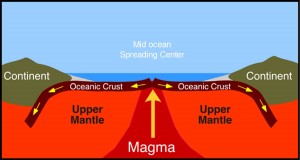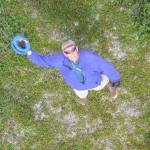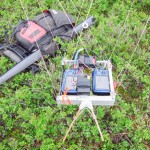This past Sunday, six people with smartphones and one guy with a pad of paper descended on a 350 acre property in the Green Mountains near Bridgewater Hollow, Vermont. The smartphone people used iNaturalist to document about 300 observations of plants and animals (and quite a few things that might be neither, like slime molds and fungi). The paper guy was Brett Engstrom whose list of vascular plants is probably longer than the list of all the species that everyone else compiled.
Tag: Forests
Stemming the tide
Below is a diagram that was never shown to me in science class. Alfred Wegener proposed his theory of continental drift in 1912, but it was not until 1960 that most scientists began to accept the new paradigm that continents move around. The idea of crust formation at mid ocean ridges came even later in 1966. So when scientists and teachers in the 1950s and 1960s presented a story about the serpentine rock underlying Soldiers Delight, they got it wrong. Serpentinite is formed in the lower oceanic crust, typically at the mid ocean spreading centers. That’s where it picks up its heavy minerals, like chromium, nickel, and magnesium, which are more abundant in the mantle and deep crust. When Africa floated over here 300 million years ago, a little bit of this oceanic rock got pushed along with it and ended up in the Appalachian Mountains, and in Soldiers Delight. Nobody knew that in 1960.

Copy that
I watched eBay auctions for Nikon D3100 cameras for a day, then started watching auctions for D5100 cameras. I assumed that the upgrade from the Nikon D40’s six megapixels had to be at least to 14 megapixels to make a noticeable improvement in copies of old Plus-X film, and I assumed that to really record the film grain, the D5100’s 16 megapixels would be required. But the D5100 was $100 more, and the raw files it makes are 20 MB, compared to 15 MB for the D3100 (and 5 MB for my old D40). The D5100 is also bigger and a bit heavier. After several D3100 auctions completed, I ordered a refurbished one from Adorama for $350, about the price used ones were going for on eBay with a kit 18-55 mm VR lens. This gave me a 90 day warranty and it was easy to order a couple of spare batteries. It arrived in 1.5 days for $6 shipping, way better than most eBay deals. Continue reading “Copy that”
Sprucing up the hills


I was able to get some aerial photos of most of the plots after I had marked each seedling with pink flagging. I flew a dual camera KAP rig with normal and infrared-modified cameras lofted by a kite. I will be experimenting with false color IR (NRG) and NDVI images which can be created with information from both cameras. Continue reading “Sprucing up the hills”
Unexpected Panorama

Earthbound NDVI
The PLOTS visible/near-infrared camera tool was ready to fly on Thursday, but the Fled could not find enough wind. So I switched on the two cameras and the timer and walked around the field making photos every 10 seconds. Continue reading “Earthbound NDVI”
Return to the Nubble
I went over to the Adirondacks last Wednesday and came back with 1900 photos. Most of them were taken by my Gigapan imager, and half of those are duplicates that will never again see the light of day. Before I even got to New York, I took 126 handheld photos from the Lake Champlain ferry, 48 of which got stitched into the three-row panorama below of the new Crown Point Bridge, still under construction. Back on August 26, the day the central “network tied arch” was lifted into position, I came to repeat the gigapan I took of the old bridge. But the place was crawling with gawkers, and the men in hard hats would not let me get to the place from which the earlier panorama had been taken. So I left defeated. If you missed it too, you can relive the raising of the arch with the fully archived construction webcams, but you have to click through a lot of photos to get to 3:30 PM on August 26 when the action started. Continue reading “Return to the Nubble”
The succession of precedence
Google has digitized the text of five million books. The old ones are in the public domain and you can read them online at http://books.google.com/. Most of the more recent ones are still protected by copyright law, but that law did not anticipate the ingenuity at Google. The individual words and phrases in all those books are now in a huge database that anyone can search. Maybe you can’t read every book online, but you can learn how book writers have used the language over the past two centuries at http://ngrams.googlelabs.com/. This allows a very new kind of literary research – answering questions without reading. Although it turns out that some reading is still required. Continue reading “The succession of precedence”
